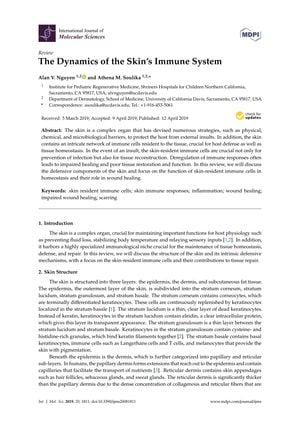The Dynamics of the Skin’s Immune System
April 2019
in “
International Journal of Molecular Sciences
”
skin immune system Langerhans cells dermal dendritic cells macrophages mast cells eosinophils T lymphocytes skin-resident memory T cells skin microbiome mesenchymal stem cells electrotherapy wound healing scarring inflammatory conditions tissue homeostasis immune cells stem cells inflammation homeostasis

TLDR The skin has a complex immune system that is essential for protection and healing, requiring more research for better wound treatment.
The 2019 document provides a comprehensive review of the skin's immune system, detailing the structure of the skin, the roles of various immune cells, and the interactions between these cells and the skin environment. It explains that the skin is composed of three layers, each with distinct functions and cell types, and houses an intricate immune system crucial for host defense and tissue homeostasis. The document discusses the functions of skin-resident myeloid cells, such as Langerhans cells, dermal dendritic cells, macrophages, mast cells, and eosinophils, in maintaining tissue function, responding to environmental challenges, and contributing to homeostasis, inflammatory conditions, and wound healing. It also covers lymphoid immune cells, including T lymphocytes and skin-resident memory T cells, and their roles in steady state and inflammatory responses. The review highlights the importance of the skin microbiome in defending against pathogens and modulating immune responses, as well as the immune responses involved in wound healing and scarring, including the potential of mesenchymal stem cells and electrotherapy in wound treatment. It concludes by emphasizing the complexity of the skin's immune system and the need for further research to develop new treatments for chronic and inflammatory wounds.
















